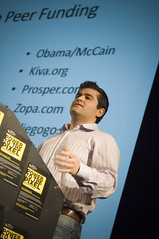Crowdsourcing: Using Audiences to Bankroll Projects
Loyal fans are the lifeblood of artists and essential to sustaining any creative career. Now, with online tools that enable direct connections, filmmakers can reach out to their fans for support in the early stages of project development. Whether aiding the funding, production or distribution of a film, crowdsourcing is a collaborative way to overcome barriers in the filmmaking process.

Iraq for Sale
When lacking financial resources for production, some filmmakers have creatively funded their films by offering to put their supporters’ names in the credits in exchange for small donations. For those true fans, the satisfaction of becoming patrons can be rewarding – especially if they sense the film would not get made without their help.
One of the first and most well known filmmakers to use crowdsourcing is Robert Greenwald. Robert funded his 2006 feature, Iraq for Sale: The War Profiteers, through small donations gathered via his production company’s website. Already having a $100,000 initial donation, Robert still needed to raise $200,000 to start work on the film. So, Brave New Films asked people on its mailing list to give $50 in exchange for special thanks in the film’s credits. In a matter of ten days, Brave New Films raised more than $265,000 from online supporters and succeeded in greenlighting Iraq for Sale. Robert talked about the alternative distribution strategies he used in a video he made for the 2007 Power to the Pixel event in London.

Matt Hanson
Matt Hanson, who spoke at the 2007 and 2008 PTTP events in London, created one of the first crowdsourced projects, A Swarm of Angels. Matt, a Brighton-based filmmaker, collaborates with a group of online supporters that now includes more than 1000 individuals. With each “angel” contributing a minimum of £25, A Swarm of Angels aims to involve thousands of people in the process of creating a £1 million film. The final version will then be given away for free via the Internet, using all-digital technologies and enabling those involved in the project to remix, use and share it as they wish.

Franny Armstrong
An article in last Saturday’s Guardian explains how British filmmaker Franny Armstrong used crowdfunding to raise money for her climate change film, The Age of Stupid. Franny raised £530,000 from 228 people and groups who, knowing that the film must take in at least £1 million before they could see a return, each made an investment of at least £500. Franny aims to reach an audience of 250 million and is launching her distribution campaign with the world’s largest ever official premiere. On 15 March, the film will show in a solar-powered cinema tent in London’s Leicester Square and be beamed by satellite directly to 65 cinemas.

Slava Rubin from IndieGoGo
With each new example of successful crowdsourcing, it seems the number of relevant online tools increases. Sites like IndieGoGo offer an online social marketplace where filmmakers can pitch their stories to the world and fans can find projects to fund. Launched at the 2008 Sundance Film Festival, IndieGoGo’s platform now hosts over 1000 projects in more than 80 countries. One of the founders, Slava Rubin, spoke at PTTP events in London and Berlin and offers Tapestries of Hope, a project about the Zimbabwean sex crisis, as an example of what can be achieved on the site. Although the $23,000 Michealene Cristini Risley’s Tapestries of Hope raised on IndieGoGo is the larget amount any project has taken in, others like Minna Packer’s The Lilliput and Daniela Kon’s Changing the World on Vacation have also raised significant sums of $10,000. IndieGoGo classifies the money as neither an investment nor a donation, but rather a purchase that strengthens the relationship between the artist and the audience.
Similarly, Massify, which facilitated the collaborative casting and creation process for the horror film Perkins 14, is essentially a social network that hosts interactive tools that facilitate production. Although the site’s crowdsourcing features are designed for users to share ideas and team up on projects, it also offers some opportunity to seek funding through grants and partnerships with distributors.
Other examples include ArtistShare, a crowdsourcing site that primarily serves musicians, which enabled Paul Devlin to raise funds for his feature documentary, BLAST! SellABand is another resource for unsigned artists looking for music lovers willing to help sponsor a recording session. Some more general crowdfunding tools include tipjoy and chipin, which the documentary project The Delegates used to raise $10,000 to fund filming at the 2008 Democratic National Convention. Additionally, Spot.Us is a site that solicits ideas for investigative journalism and enables citizens to donate the money to sponsor the reporting.
Crowdsourcing is not a simple solution, but the new tools available have made it easier for artists to explore using their audiences to bankroll their projects. Even if artists fail to raise substantial funds, attempting to commoditise and exploit the production process will likely pay off in a stronger relationship with their fans and greater exposure for their projects.